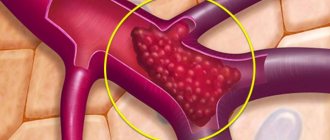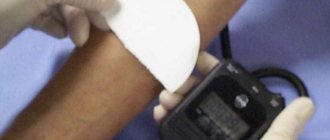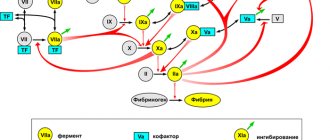This study is an identification of polymorphisms in genes associated with hereditary thrombophilia and other disorders of the blood coagulation system. Thrombophilia is an increased tendency to random (for no apparent reason) deep vein thrombosis and thromboembolic complications. Thrombosis can occur due to circulatory disorders (blood stagnation), increased ability of the blood to form blood clots (hypercoagulation), damage to the vascular wall, and a combination of these factors. Hypercoagulation may be due to the presence of a genetic predisposition to thrombophilia (the most common polymorphisms in the F2 and F5 genes), which this analysis can identify.
In what cases is research usually prescribed?
The analysis is recommended for the following categories of patients:
- patients with a family history of thrombophilia and other venous complications
- patients with a family history of cardiovascular events (heart attacks and strokes) in close relatives under the age of 50 years
- women planning to take combined
- patients with thrombosis of any location under the age of 50 years, even in the presence of predisposing factors
- patients with thrombosis of unusual sites (thrombosis of the cerebral sinuses, mesenteric, hepatic veins)
- patients with chronic venous diseases, in particular with thrombophlebitis
- women planning to take combined oral contraceptives
- women planning hormone replacement therapy
- women with recurrent miscarriage.
A comprehensive genetic analysis that allows you to determine the risk of thrombophilia. It is a molecular genetic study of the genes of blood clotting factors, platelet receptors, fibrinolysis, folic acid metabolism, changes in the activity of which directly or indirectly determine the tendency to increased thrombosis.
What biomaterial can be used for research?
Buccal (buccal) epithelium, venous blood.
How to properly prepare for research?
No preparation required.
More about the study
As a result of various pathological processes, blood clots can form in the vessels, blocking blood flow. This is the most common and unfavorable manifestation of hereditary thrombophilia - an increased tendency to form blood clots associated with certain genetic defects. It can lead to the development of arterial and venous thrombosis, which in turn often causes myocardial infarction, coronary heart disease, stroke, pulmonary embolism, etc.
The hemostasis system includes factors of the blood coagulation and anticoagulation systems. In a normal state, they are in balance and provide the physiological properties of the blood, preventing increased thrombus formation or, conversely, bleeding. But when exposed to external or internal factors, this balance can be disrupted.
As a rule, genes for blood coagulation factors and fibrinolysis, as well as genes for enzymes that control folic acid metabolism, are involved in the development of hereditary thrombophilia. Disturbances in this metabolism can lead to thrombotic and atherosclerotic vascular lesions (through an increase in the level of homocysteine in the blood).
The most significant disorder leading to thrombophilia is a mutation in the clotting factor 5 (F5) gene, also called Leiden mutation. It is manifested by the resistance of factor 5 to activated protein C and an increase in the rate of thrombin formation, which results in an increase in blood clotting processes. Also an important role in the development of thrombophilia is played by a mutation in the prothrombin gene (F2), associated with an increase in the level of synthesis of this coagulation factor. In the presence of these mutations, the risk of thrombosis increases significantly, especially due to provoking factors: taking oral contraceptives, excess weight, physical inactivity, etc.
Carriers of such mutations have a high probability of an unfavorable course of pregnancy, for example, miscarriage, intrauterine growth retardation.
Predisposition to thrombosis may also be due to a mutation in the FGB gene encoding the beta subunit of fibrinogen (genetic marker FGB (-455GA). The result is an increase in fibrinogen synthesis, resulting in an increased risk of peripheral and coronary thrombosis, the risk of thromboembolic complications during pregnancy, childbirth and in the postpartum period.
Among the factors that increase the risk of developing thrombosis, platelet receptor genes are very important. This study analyzes the genetic marker of the platelet receptor gene for collagen (ITGA2 807 C>T) and fibrinogen (ITGB3 1565T>C). With a defect in the collagen receptor gene, platelet adhesion to the vascular endothelium and to each other increases, which leads to increased thrombus formation. By analyzing the ITGB3 1565T>C genetic marker, it is possible to identify the effectiveness or ineffectiveness of antiplatelet therapy with aspirin. With disorders caused by mutations in these genes, the risk of thrombosis, myocardial infarction, and ischemic stroke increases.
Thrombophilia may be associated not only with disorders of the blood coagulation system, but also with mutations in the genes of the fibrinolytic system. The genetic marker SERPINE1 (-675 5G>4G) is an inhibitor of plasminogen activator, the main component of the blood anticoagulation system. An unfavorable variant of this marker leads to a weakening of the fibrinolytic activity of the blood and, as a result, increases the risk of vascular complications and various thromboembolisms. The SERPINE1 gene mutation is also observed in some pregnancy complications (miscarriage, fetal growth retardation).
In addition to mutations in coagulation and anticoagulation factors, elevated homocysteine levels are considered a significant cause of thrombophilia. When excessively accumulated, it has a toxic effect on the vascular endothelium and affects the vascular wall. Blood clots form at the site of damage, and excess cholesterol can settle there. These processes lead to blockage of blood vessels. Excess homocysteine (hyperhomocysteinemia) increases the likelihood of developing thrombosis in blood vessels (both arteries and veins). One of the reasons for the increase in homocysteine levels is a decrease in the activity of enzymes that ensure its metabolism (the MTHFR gene was included in the study). In addition to the genetic risk of developing hyperhomocysteinemia and associated diseases, the presence of changes in this gene allows one to determine a predisposition to an unfavorable course of pregnancy (fetoplacental insufficiency, patent neural tube and other complications for the fetus). If there are changes in the folate cycle, folic acid and vitamins B6, B12 are prescribed as prophylaxis. The duration of therapy and dosage of drugs can be determined based on the genotype, homocysteine level and characteristics of the associated risk factors in the patient.
It is possible to suspect a hereditary predisposition to thrombophilia if there is a family and/or personal history of thrombotic diseases (deep vein thrombosis, varicose veins, etc.) and also in obstetric practice - with thromboembolic complications in women during pregnancy and the postpartum period.
A comprehensive molecular genetic study allows one to assess the genetic risk of trobophilia. Knowing about genetic predisposition, you can prevent the development of cardiovascular disorders by timely preventive measures.
Risk factors for thrombophilia:
- bed rest (more than 3 days), prolonged immobilization, long static loads, including those related to work, sedentary lifestyle;
- use of oral contraceptives containing estrogens;
- excess body weight;
- history of venous thromboembolic complications;
- catheter in the central vein;
- dehydration;
- surgical interventions;
- injury;
- smoking;
- oncological diseases;
- pregnancy;
- concomitant cardiovascular diseases, malignant neoplasms.
When is the study scheduled?
- If there is a family history of thromboembolism.
- If there is a history of thrombosis.
- For thrombosis under the age of 50 years, repeated thrombosis.
- In case of thrombosis at any age in combination with a family history of thromboembolism (pulmonary embolism), including thrombosis of other locations (cerebral vessels, portal veins).
- For thrombosis without obvious risk factors over the age of 50 years.
- In the case of the use of hormonal contraceptives or hormone replacement therapy in women: 1) with a history of thrombosis, 2) whose 1st degree relatives had thrombosis or hereditary thrombophilia.
- With a complicated obstetric history (miscarriage, fetoplacental insufficiency, thrombosis during pregnancy and in the early postpartum period, etc.).
- When planning pregnancy by women suffering from thrombosis (or in the case of thrombosis in their 1st degree relatives).
- Under such high-risk conditions as abdominal surgery, prolonged immobilization, constant static loads, and a sedentary lifestyle.
- With a family history of cardiovascular diseases (cases of early heart attacks and strokes).
- When assessing the risk of thrombotic complications in patients with malignant neoplasms.
What do the results mean?
Based on the results of a comprehensive study of 10 significant genetic markers, a conclusion from a geneticist is issued, which will allow one to assess the risk of thrombophilia, predict the development of diseases such as thrombosis, thromboembolism, heart attack, or the likelihood of complications associated with impaired hemostasis during pregnancy, choose directions for optimal prevention, and already existing clinical manifestations, understand their causes in detail.
What exactly is determined during the analysis process?
This study identifies polymorphisms of the following genes:
- F2 - prothrombin gene.
- F5 – blood clotting factor V gene.
- F7 – proconvertin gene.
- F13A1 is a gene encoding the A subunit of coagulation factor XIII.
- FGB is a gene encoding the beta subunit of fibrinogen.
- ITGA2 is a gene encoding platelet glycoprotein Ia.
- ITGB3 is a gene encoding the beta-3 integrin protein, which is a component of platelet glycoprotein IIb/IIIa.
- SERPINE1 (PAI-I) – plasminogen activator inhibitor type 1 gene.
Causes of pathology
As a result of various pathological processes in the body, blood clots can form that block blood flow. Most often, this phenomenon is caused by a mutation in the clotting factor gene (or, as it is also called, Leiden). A mutation in the prothrombin gene can also lead to the development of pathology.
If a patient has even one of these mutations, the risk of thrombophilia increases several times. Various provoking factors can also worsen the situation:
- excess weight;
- taking oral contraceptives;
- smoking;
- sedentary lifestyle;
- oncological pathologies;
- IVF protocols;
- pregnancy period.
What do the test results mean?
As a conclusion, a genetic health card is issued, compiled by a professional geneticist in our laboratory. It presents the results of the analysis with interpretation, provides a detailed description of the studied polymorphisms and their impact on the risks of developing disorders of the blood coagulation system, cardiovascular diseases and pathologies of pregnancy, advice on conducting additional studies and detailed clinical recommendations for the attending physician.
The results of the analysis are interpreted by the attending physician. Based on them, the doctor can adjust the patient’s diet and lifestyle, prescribe medications and additional tests.
Why get tested for hereditary thrombophilia?
Each person is recommended to undergo a genetic mapping procedure (gene study) and exclude a hereditary tendency to blood clots.
Risk factors that activate thrombophilia genes in a completely healthy person are:
- operations in the area of large main vessels - on the hip joint, pelvic organs;
- metabolic disorders in the body - diabetes, obesity;
- hormonal therapy - replacement, when planning IVF, taking contraceptives;
- physical inactivity - restriction of physical activity;
- pregnancy and postpartum period.
Analysis for genetic thrombophilia is especially relevant when planning pregnancy or IVF. In pregnant women, the level of blood clotting factors 1, 5 and 8 increases, and the activity of the anticoagulation mechanism, on the contrary, decreases. With a hereditary tendency to thrombosis, these physiological changes in the body can provoke recurrent miscarriage, placental insufficiency, placental abruption, intrauterine growth restriction and other obstetric complications.
Knowing about the patient’s tendency to venous thrombosis, the doctor will be able to prescribe anticoagulant therapy, recommend a diet, and provide competent pregnancy support to the expectant mother with genetic thrombophilia.
Decoding the thrombophilia test
With thrombophilia, a person receives from his parents 1 normal and 1 altered copy of the gene (heterozygous mutation), or 2 mutated genes at once. The second variant of the polymorphism, homozygous, indicates a high risk of developing thrombosis.
The test for thrombophilia includes the study of 8 genes responsible for the mechanisms of hemostasis - the blood coagulation system:
- Gene F13A1 - polymorphism of the 13th coagulation factor causes a tendency to hemorrhagic syndrome, hemarthrosis, thrombosis.
- ITGA2 - changes in the integrin gene indicate the risk of ischemic stroke and thrombosis in the postoperative period.
- Serpin1 gene - a mutation of this DNA section is unfavorable for pregnancy: it provokes recurrent miscarriage, fading and intrauterine growth restriction of the fetus, preeclampsia.
- F5, Leiden factor - affects pregnancy in the 2nd and 3rd trimesters, creates a tendency to thrombosis of the arteries and veins of the lower extremities.
- FGB - fibrinogen polymorphism indicates the risk of strokes, miscarriage and fetal hypoxia.
- ITGB3 - gene mutation makes possible the occurrence of thromboembolism, myocardial infarction and spontaneous abortion.
- F7 - the seventh plasma factor is responsible for hemorrhagic syndromes in newborns.
- F2 - changes in 2 prothrombin genes are an indirect cause of thromboembolism, strokes, postoperative and obstetric complications.
Video about the prevention of complications in pregnant women with thrombophilia
Principles of preventing pregnancy complications in thrombophilia (part 1)
Thrombophilia is the most important link in the development of pregnancy complications. Issues of fetal loss, preeclampsia, thromboembolic complications associated with disorders of the blood coagulation system are covered by Victoria Omarovna Bitsadze, professor, hemostasiologist, obstetrician-gynecologist at the Women's Medical Center.
obstetrician-gynecologist, hemostasiologist
Bitsadze Victoria Omarovna
Where to get tested for genetic thrombophilia
Detailed diagnosis of thrombophilia and other genetic mutations of hemostasis is carried out in the experimental laboratory of the MLC. With us you can get advice from a geneticist, hemostasiologist and undergo all the necessary studies when planning a pregnancy.
Blood tests are performed using electronic analyzers and specific reagents, which guarantees their 100% accuracy. You can find out the cost and sign up for an examination from the administrator of the Women's Medical Center.





